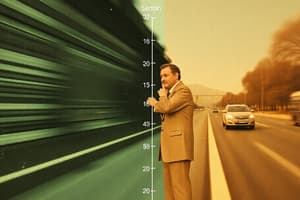Podcast
Questions and Answers
What distinguishes speed from velocity?
What distinguishes speed from velocity?
- Speed considers only the distance covered.
- Velocity includes direction while speed does not. (correct)
- Velocity measures how fast an object moves regardless of distance.
- Speed has units of time, while velocity has units of distance.
If a car travels 180 km in 3 hours, what is its speed?
If a car travels 180 km in 3 hours, what is its speed?
- 90 km/hr
- 60 km/hr (correct)
- 100 km/hr
- 30 km/hr
How is speed calculated?
How is speed calculated?
- By dividing change in time by distance
- By dividing change in position by time (correct)
- By calculating the average of distances over multiple time intervals
- By adding distance and time
What would increase an object's speed based on the content?
What would increase an object's speed based on the content?
If a person jogs 36 meters in 4 seconds, what is their speed?
If a person jogs 36 meters in 4 seconds, what is their speed?
Flashcards
Speed
Speed
Speed is the rate at which an object changes its position over time. It describes how fast or slow an object is moving.
Speed Formula
Speed Formula
Speed is calculated by dividing the change in distance (ΔX) by the change in time (t).
Scalar quantity
Scalar quantity
A quantity that has only magnitude (size) and no direction.
Vector quantity
Vector quantity
Signup and view all the flashcards
Calculating speed
Calculating speed
Signup and view all the flashcards
Units of Speed
Units of Speed
Signup and view all the flashcards
Study Notes
Speed
- Speed is a change of position over time.
- It also shows how fast or slow an object is moving.
- Speed is a scalar quantity, meaning it only has magnitude.
- Velocity is a vector quantity, having both magnitude and direction.
Formula
- Speed = change of position / time
- V = Δx / t (where V = speed, Δx = change in position, t = time)
- Units are typically meters per second (m/s).
Calculating Speed
-
The greater the distance traveled in a shorter time, the greater the speed.
-
A steeper slope on a distance-time graph indicates a greater speed.
-
The slope of a distance-time graph represents speed.
- Speed = rise / run where rise is the change in distance and run is the change in time.
-
A horizontal line on a distance-time graph means the object is stationary.
-
A downward sloping line on a distance-time graph indicates the object is going back towards its starting point.
Examples
- Example 1: A bus travels 250 meters in 10 seconds. Speed = 25 m/s.
- Example 2: A person walks 45 meters in 5 seconds. Speed = 9m/s
- Example 3: A boat travels 140 kilometers in 2 hours. Speed = 70 km/hr
Studying That Suits You
Use AI to generate personalized quizzes and flashcards to suit your learning preferences.




